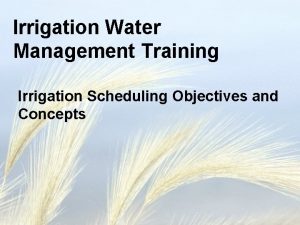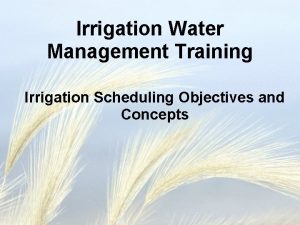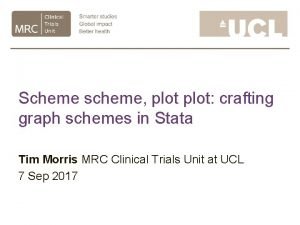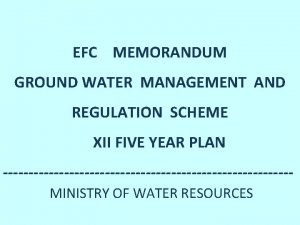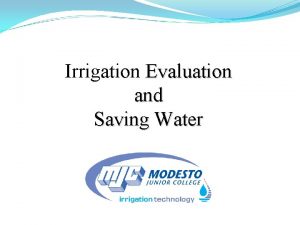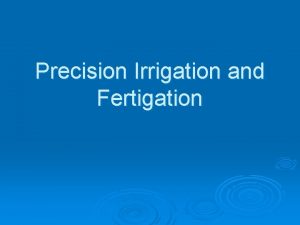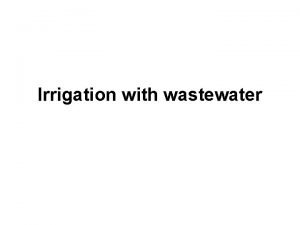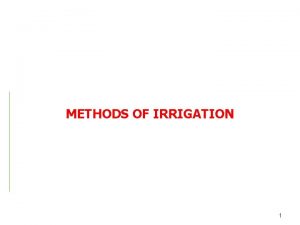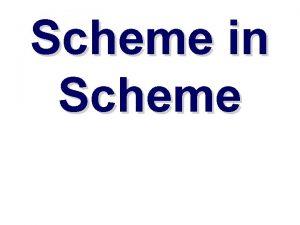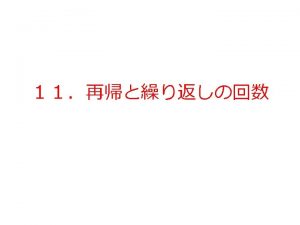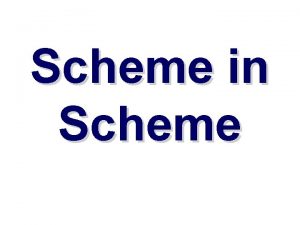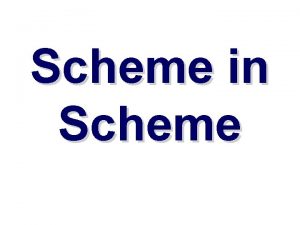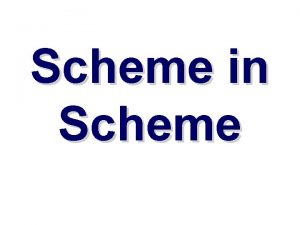Water Saving in the SemiArid Doukkala Irrigation Scheme















- Slides: 15

Water Saving in the Semi-Arid Doukkala Irrigation Scheme (Western Morocco) Fatima-Ezzahra El Ghandour, Adnane Habib, Youssef Houali, Yassine Labbassi, Lorenzo Iannini, Silvia Maria Alfieri, Kamal Labbassi and Massimo Menenti - DBAR_ICo. E-EOAWARE, LGMSS-URAC 45, Department of Earth sciences, Faculty of Sciences, Chouaib Doukkali University, Morocco; - Department of Geosciences and Remote Sensing, Delft University of Technology, The Netherlands; - State Key Laboratory of Remote Sensing Science, Institute of Remote Sensing and Digital Earth, Chinese Academy of Sciences, China - Faculty of Sciences Ain Chock, Hassan II University, Morocco European Geosciences Union (EGU), General Assembly 2020. Vienna, Austria Center Vienna (ACV), from 4 th to 8 th May 2020.

OUTLINE 1 Introduction & Background 2 Objectives 3 4 Data collection Data acquisition and methodology: -Satellite data -Agro-meteorological data - Methodology Results and Discussion: 5 Conclusions

92 19 199 93 3 -1 19 99 94 4 19 199 95 5 -1 19 99 96 6 19 199 97 7 19 199 98 8 -1 19 99 99 9 -2 20 00 01 1 -2 20 002 02 -2 20 00 03 3 -2 20 00 04 4 -2 20 00 05 5 -2 20 006 06 -2 20 00 07 7 -2 20 00 08 8 -2 20 00 09 9 -2 20 010 10 -2 20 011 11 -2 20 012 12 -2 20 013 13 -2 20 014 14 -2 20 01 15 5 -2 20 016 16 -2 01 7 19 INTRODUCTION & BACKGROUND Average annual precipitation (mm / year) of the Doukkala irrigation scheme between 1992 and 2017 Oued Oum Er-rabia 600 300 [VALEUR] mm/an 500 400 Barrage Al Massira 200 100 0 Irrigation season

INTRODUCTION & BACKGROUND Casier Faregh Sugar beet Surface irrigation Wheat Casier S. Smail- S. Bennour Casier Zemamra Sprinkler irrigation Casier T. Gharbia Maize Alfalfa Drip irrigation

OBJECTIVES The main objective of MOSES is to put in place and demonstrate at the real scale of application an information platform devoted to water procurement and management agencies to facilitate planning of irrigation water resources, with the aim of: • Saving water; • Improving services to farmers; • Reducing monetary and energy costs.

MOSES Products Weather forecast Daily and weekly Seasonal forecast of irrigation water requirements Short term irrigation forecast Crop water demand (CWD) In season irrigation forecast Early Crop Mapping (ECM) In season crop mapping (ICM)

DATA COLLECTION Meteorological data: Ø Hourly and daily meteorological data Température Tmax(°C) Tmin(°C) Humidité relative Tmoy(°C) HRmax(%) HRmin(%) HRmoy(%) Rs (MJ/m 2) Vent (m/s) Pluie (mm) ET 0 (mm/j) ØWater allocations per quarters per CGRs Ø Crop calender: September October November December January February Sugar beet Wheat Maize Alfalfa March April May June July August

DATA ACQUISITION 06/12/2016 13/12/2016 -2017 23/12/2016 26/12/2016 2017 -2018 02/01/2017 05/01/2017 12/01/2017 Pilot area: Sidi Bennour 15/01/2017 25/01/2017 01/02/2017 14/02/2017 06/03/2017 OL I 05/04/2017 LA ND SA T 8 12/04/2017 25/04/2017 SE NT INE L-2 MS I+ 02/05/2017

APPROACH OR METHODOLOGY The MOSES in season crop water demand module Multispectral Satellite Data short-term meteorological forecast Landsat-8 and Sentinel-2 Precipitation, ET 0, T, RH. . . The main functionalities are: • Monitoring of crop phenological variables and crop water demand at 7 days temporal resolution or higher, depending on the availability of multispectral remote sensing observations. • 7 days forecast of crop water demand Crop phenological variables and crop water demand Crop water demand variables: methodologies Fao-56: Kc-NDVI method Analytical approach NDVI Net shortwave radiation Rns Albedo Canopy resistance rc, min LAI Aerodynamic resistance ra hc Kc ETc=Kc*ET 0

APPROACH / METHODOLOGY Multispectral Satellite Data Landsat-8 and Sentinel-2 Image Preprocessing Cloud Masking Image selection 7 -days Reference evapotranspiration Observed weather data Short term weather forecat Calculation of crop phenological variables Albedo, LAI and NDVI Kc estimated with analytical method Kc estimated with empirical method Computation of daily CWDF and GIWDF Maps Computation of weekly CWDF Computation of weekly GIWDF = CWDF-P Precipitation forecat

RESULTS From 25/03/2018 to 31/03/2018 From 20/11/2017 to 26/11/2017 30 15 25 10 20 5 Winter 0 -5 337 331 333 338 330 335 mm/week 20 336 15 10 5 -10 0 -15 337 CGRs CWDF (emp) GIWRF (emp) CWDF (an) GIWRF (an) 331 CWDF (emp) From 16/04/2018 to 22/04/2018 30 Spring mm/week 25 20 15 10 5 0 337 331 CWDF (emp) 333 GIWRF (emp) CWDF : Crop Water Demand Forecast GIWDF : Gross Irrigation Water Demand Forecast= CWDF – P. 338 CGRs 330 CWDF (an) 335 GIWRF (an) 336 333 GIWRF (emp) 338 CGRs 330 CWDF (an) 335 GIWRF (an) 336

RESULTS From 25/03/2018 to 31/03/2018 20 30 15 25 mm/week From 20/11/2017 to 26/11/2017 10 5 0 -5 337 331 333 338 330 335 20 15 10 5 336 0 -10 337 CGRs CWDF (emp) GIWRF (emp) Allocation CWDF (an) GIWRF (an) 331 CWDF (emp) From 16/04/2018 to 22/04/2018 35 mm/week 30 25 20 15 10 5 0 337 CWDF (emp) 331 333 GIWRF (emp) 338 CGRs Allocation 330 CWDF (an) CWDF : Prévisions de la demande en eau pour les cultures GIWDF : Prévisions brutes de la demande en eau d’irrigation = CWDF – P. 335 336 GIWRF (an) 333 GIWRF (emp) 338 CGRs Allocation 330 CWDF (an) 335 336 GIWRF (an)

RESULTS

CONCLUSIONS • CWD calculated by the analytical method is greater than the one calculated by the empirical and the differences are larger in spring than in winter. This is probably due to the development stage of the crop in spring. • The differences between GIWDR and the allocation suggested that the precipitation is not taken into account by Ormvad when the water to allocate to the CGRs is defined at the beginning of the irrigation period. • The results confirmed the potential value of MOSES services in improving irrigation management in the area. The use of CWDF during the in season irrigation management operations would help the water management authority to save water, especially during the winter season. • The use of MOSES products during the irrigation management operations would help the water management authority to save water, especially during the winter season, leaving additional water available to meet requirements in spring and summer.

THANK YOU
 Water and water and water water
Water and water and water water Objectives of irrigation
Objectives of irrigation Objectives of irrigation
Objectives of irrigation 3 domain scheme and 5 kingdom scheme
3 domain scheme and 5 kingdom scheme Scheme stata
Scheme stata Pyramid scheme vs ponzi scheme
Pyramid scheme vs ponzi scheme Ground water management and regulation scheme
Ground water management and regulation scheme Hình ảnh bộ gõ cơ thể búng tay
Hình ảnh bộ gõ cơ thể búng tay Ng-html
Ng-html Bổ thể
Bổ thể Tỉ lệ cơ thể trẻ em
Tỉ lệ cơ thể trẻ em Voi kéo gỗ như thế nào
Voi kéo gỗ như thế nào Glasgow thang điểm
Glasgow thang điểm Bài hát chúa yêu trần thế alleluia
Bài hát chúa yêu trần thế alleluia Các môn thể thao bắt đầu bằng tiếng đua
Các môn thể thao bắt đầu bằng tiếng đua Thế nào là hệ số cao nhất
Thế nào là hệ số cao nhất

